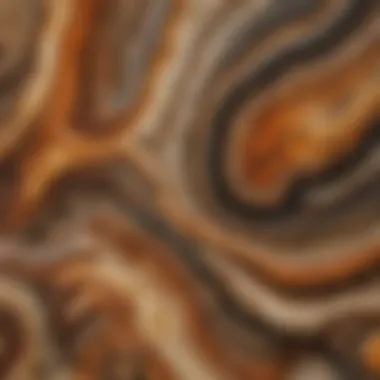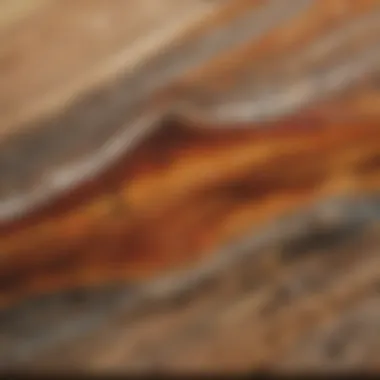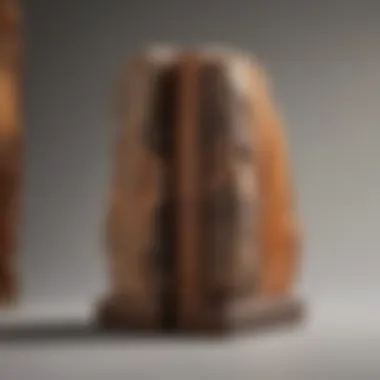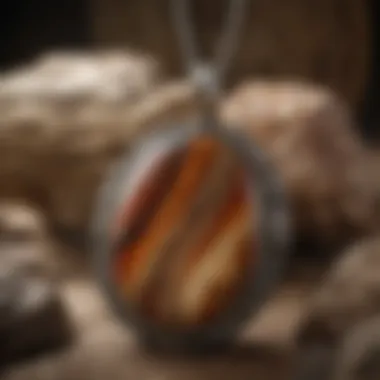Discover the Exquisite World of Polished Petrified Wood for Sale


Rock and Fossil Identification
Polished petrified wood is a unique specimen that blurs the line between rock and fossil, making it a fascinating subject for collectors and enthusiasts alike. When identifying this geological treasure, it's crucial to understand the types of rocks and fossils it originates from. Petrified wood is essentially fossilized wood where the organic materials have been replaced by minerals, resulting in a stony texture and appearance. Characteristics to look for include vibrant colors, intricate growth rings, and detailed wood grain patterns.
To aid in identification, collectors can utilize various tools such as hand lenses, geologist hammers, and magnifying glasses to examine the fine details of the petrified wood specimen.
Collecting Tips and Techniques
For avid collectors looking to add polished petrified wood to their collection, it's essential to follow best practices for collecting. Locating prime collecting sites often involves researching areas with ancient forests or geological formations where petrified wood is likely to be found. When extracting specimens, it's important to do so safely and responsibly to preserve the integrity of the wood.
To safely extract petrified wood, tools such as rock picks, shovels, and brushes can be used while being cautious not to damage the specimen during removal.
Preservation and Display
Preserving polished petrified wood is crucial to maintaining its beauty and integrity over time. Techniques such as coating the wood with a protective sealant can help prevent moisture damage and ensure its longevity. Proper storage methods involve keeping the specimens in a controlled environment with stable temperature and humidity levels.
When it comes to creative display ideas, collectors can showcase their polished petrified wood in shadow boxes, on stands, or as part of a larger rock and fossil collection for a visually appealing presentation.
Geological Insights
Exploring the geological aspects of polished petrified wood unveils a deeper understanding of its origins and formation. These specimens often stem from ancient forests that were buried over millions of years, undergoing the process of permineralization to transform into petrified wood. This fossilization process provides insights into the historical vegetation and environmental conditions of the past.
The historical significance of petrified wood lies in its ability to bridge the gap between ancient ecosystems and modern-day geological studies. Notable discoveries of petrified forests in various parts of the world have shed light on the Earth's past, contributing to our understanding of evolution and climate change.
Introduction to Polished Petrified Wood
Polished petrified wood is a captivating subject that appeals to collectors and enthusiasts alike. The allure of this fossilized wood lies in its unique properties, which reflect the ancient natural processes it underwent over time. In this article, we will delve deep into the world of polished petrified wood, exploring its formation, significance, and where to find specimens for sale. From its rich history to its potential decorative and spiritual value, polished petrified wood offers a multidimensional appeal that caters to individuals with a keen interest in geological wonders and natural beauties.
Understanding Petrified Wood Formation


When delving into the realm of petrified wood, it's essential to grasp the intricate processes that transpired to give rise to this stunning material. The mineral replacement process stands as a pivotal aspect of petrified wood formation, where organic matter is gradually replaced by minerals, maintaining the structural integrity of the original wood. This preservation of cell structure ensures that the fossil retains its detailed characteristics, offering a glimpse into the history of these ancient forests. The resulting coloration and textures provide a visual tapestry that showcases the beauty of nature's transformative power.
Mineral Replacement Process
The mineral replacement process is a crucial component in the creation of petrified wood. It involves minerals such as silica, calcite, and pyrite infiltrating the cellular structure of wood and gradually replacing organic material. This process ensures the retention of intricate details and maintains the original woody texture, culminating in the stunning appearance of polished petrified wood. The advantages of this process include the preservation of delicate features and the establishment of a durable fossil that encapsulates the essence of ancient plant life.
Preservation of Cell Structure
Preservation of cell structure is a defining factor in the quality of petrified wood. It involves the maintenance of microscopic details at a cellular level, safeguarding anatomical features and ensuring the fidelity of the fossilized specimen. This meticulous preservation process enables researchers and enthusiasts to study ancient plant structures with unparalleled precision, offering valuable insights into prehistoric flora. The advantages of preserved cell structure in petrified wood include the clarity of visualization and the preservation of botanical characteristics.
Coloration and Texture
The coloration and texture of petrified wood are a result of various factors, including mineral composition, environmental conditions, and the duration of fossilization. Different minerals imbue the wood with a diverse palette of hues, ranging from warm earth tones to vibrant crystalline shades. Texturally, petrified wood exhibits a unique blend of smooth surfaces and intricate patterns, reflecting the organic intricacies of its origin. These features add aesthetic depth to polished petrified wood, making each piece a remarkable fusion of art and geology.
Significance of Polished Petrified Wood
The importance of polished petrified wood extends beyond its aesthetic appeal, encompassing historical, geological, and even spiritual dimensions. While its decorative value
Factors to Consider When Purchasing Polished Petrified Wood
When delving into the world of polished petrified wood, understanding the key factors to consider when making a purchase is crucial. This article aims to provide a comprehensive guide for buyers, highlighting essential elements that collectors and enthusiasts should take into account to ensure they acquire genuine and high-quality specimens. By focusing on authenticity, quality, and pricing aspects, this section will offer valuable insights to help readers make informed decisions.
Authenticity and Certification
Verification of Source
Exploring the authenticity of the source plays a pivotal role in the purchasing process of polished petrified wood. By verifying the origin of the specimen, buyers can ascertain its provenance and ensure it is not a replica or counterfeit. This step is vital for collectors who seek genuine pieces with a documented history of formation, enhancing both the value and credibility of their collections.
Certified Documentation
Certified documentation adds another layer of assurance to buyers, providing official records that validate the authenticity and quality of the polished petrified wood. These documents serve as a guarantee of the item's provenance, characteristics, and geological significance, offering peace of mind to collectors and investors alike. Furthermore, certified documentation enhances the overall transparency of the transaction, fostering trust between buyers and sellers in the market.


Expert Evaluation
Engaging expert evaluators is a prudent step in the procurement process of polished petrified wood. These professionals bring specialized knowledge and experience to assess the quality, craftsmanship, and value of the specimen accurately. Expert evaluations offer buyers an objective perspective on the item, helping them make well-informed decisions based on expert opinions and appraisals. By relying on expert evaluations, buyers can mitigate the risk of purchasing substandard or misrepresented pieces, safeguarding their investments effectively.
Quality and Craftsmanship
Fine Polishing Techniques
The art of fine polishing techniques distinguishes exceptional polished petrified wood pieces from average ones. Skilled craftsmen employ precise and labor-intensive methods to bring out the natural lustre and intricate patterns of the fossilized wood. Fine polishing enhances the visual appeal and tactile quality of the specimen, unveiling its hidden beauty and geological characteristics with precision and finesse.
Smooth Finish
A smooth finish is a hallmark of superior craftsmanship in polished petrified wood. Achieving a seamless and glossy surface requires meticulous attention to detail and expert handling of cutting and polishing tools. The smooth finish not only enhances the tactile experience of the specimen but also showcases the fossil's intricate structures and vibrant colors with clarity and elegance.
Distinctive Patterns
Distinctive patterns are the signature features that make each polished petrified wood piece unique and captivating. These patterns result from the complex interplay of minerals, organic matter, and geological processes that occurred over millions of years, creating visually stunning designs and textures. Collectors appreciate the diversity and complexity of patterns found in polished petrified wood, with each piece telling a story of its ancient origins and transformation through time.
Price Range and Budgeting
Determining Value
Determining the value of polished petrified wood involves a comprehensive assessment of its rarity, quality, and aesthetic appeal. Factors such as size, coloration, fossil inclusions, and overall condition contribute to the overall value of the specimen. By evaluating these criteria and comparing them to market standards, buyers can establish a realistic price range for their desired pieces, ensuring a fair and equitable transaction for both parties involved.
Comparative Market Analysis
Conducting a comparative market analysis enables buyers to gauge the pricing trends and demand levels for polished petrified wood within the collecting community. By studying the prices of similar specimens in the market, buyers can determine the average market value and identify any potential outliers or anomalies. This analysis assists buyers in making informed decisions regarding pricing negotiations and budget allocations, optimizing their purchasing strategies for acquiring desired specimens effectively.
Budget-Friendly Options
For buyers operating within constrained budgets, exploring budget-friendly options can provide viable alternatives for acquiring polished petrified wood without compromising on quality or authenticity. These options may include smaller specimens, pieces with minor imperfections, or items from less renowned sources, offering entry points for new collectors or enthusiasts with limited financial resources. By considering budget-friendly options, prospective buyers can diversify their collections and gradually increase their investments in polished petrified wood over time, aligning their purchases with their financial capabilities and collecting goals.


Caring for Polished Petrified Wood
In the realm of polished petrified wood, caring for these exquisite geological treasures is paramount to maintaining their beauty and integrity over time. This article recognizes the significance of proper care and maintenance for polished petrified wood as it plays a crucial role in preserving its unique qualities and ensuring its longevity for generations to come. By focusing on the specific elements, benefits, and considerations associated with caring for polished petrified wood, this section provides valuable insights for enthusiasts and collectors seeking to protect their prized specimens.
Maintenance Tips
Maintenance is essential in safeguarding the luster and condition of polished petrified wood. Here are the key aspects to consider:
Avoiding Direct Sunlight
Avoiding direct sunlight is vital in preventing the fading and deterioration of polished petrified wood due to prolonged exposure to UV rays. This proactive measure helps preserve the vibrant colors and intricate details of the specimens, ensuring that they retain their aesthetic appeal and historical value. By shielding polished petrified wood from harsh sunlight, collectors and enthusiasts can prolong the splendor of these geological marvels.
Regular Dusting and Cleaning
Regular dusting and cleaning are fundamental maintenance practices that remove dust, debris, and contaminants from the surface of polished petrified wood. This routine upkeep not only enhances the visual allure of the specimens but also prevents the accumulation of dirt that could potentially harm their structure. By incorporating regular cleaning into their maintenance regimen, collectors can uphold the pristine appearance of polished petrified wood.
Applying Protective Sealants
Applying protective sealants serves as a protective barrier against external factors that may compromise the integrity of polished petrified wood. These sealants create a shield that safeguards the surface from scratches, stains, and moisture, preserving the sheen and quality of the specimens. By utilizing appropriate sealants, collectors can ensure the long-term durability and beauty of their polished petrified wood, enhancing its resilience against environmental stressors.
Appreciating the Beauty of Polished Petrified Wood
Polished petrified wood holds a distinct allure that appeals to collectors and enthusiasts alike. In this article, the focus on appreciating the beauty of polished petrified wood sheds light on the mesmerizing elements and intrinsic value that make it a coveted geological treasure. Delving into the intricate details and exceptional qualities of polished petrified wood allows aficionados to truly grasp the essence and significance of this unique material.
Artistic Appeal and Aesthetic Value
Unique Patterns and Colors
The mesmerizing beauty of polished petrified wood lies in its unique patterns and vibrant colors, showcasing nature's artistry frozen in time. The intricate designs and striking hues of polished petrified wood create a visual spectacle that captivates the eye. Each piece tells a tale of ancient forests and geological processes, making it a fascinating addition to any collection. The distinct patterns and colors serve as a testament to the natural wonder of petrified wood, adding depth and artistry to any environment where it is displayed.
Intriguing Fossil Inclusions
The presence of fossil inclusions in polished petrified wood adds a layer of intrigue and historical significance to each piece. Fossils preserved within the wood provide a glimpse into prehistoric ecosystems and ancient life forms, making each specimen a treasure trove of scientific and educational value. The inclusion of fossils enhances the aesthetic appeal of polished petrified wood, creating a dynamic storytelling element that sparks curiosity and fascination among collectors and enthusiasts.
Versatile Decorative Options
Beyond its natural beauty, polished petrified wood offers a range of versatile decorative options for interior design enthusiasts. From accent pieces in a minimalist setting to statement decor in a bohemian chic space, polished petrified wood adapts seamlessly to various design styles. Its organic textures and earthy shades complement both modern and traditional aesthetics, making it a versatile choice for enhancing the visual appeal of any room. The decorative versatility of polished petrified wood makes it a timeless and sophisticated addition to any home or collection.







